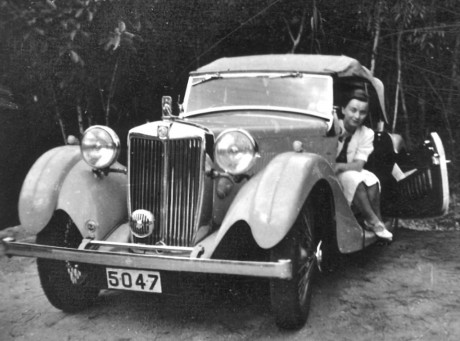Editor’s note: This is the second in a series of stories about vehicles owned and ridden or driven by the late Lindsay Lafford, Lord of Ridley who passed away in April 2014 at the age of 101½. One of Lindsay’s sons, Peter, is completing these stories as a Father’s Day memorial.

After the Austin Seven came a Morris Cowley convertible and a Riley San Remo, but then I left for Hong Kong, where my first car was a Morris Minor, a two-seat convertible that was real fun, but not sporty enough.
MGs — a J2, a Magna six-cylinder and a T — followed. The Magna was a four-seater, but I had a body shop convert it to a streamlined two-seater with sort of ducktail rear end.
Much bigger and thirstier than the MGs was a 1937 Studebaker coupe. I was living near a fishing village called Taipo and had to drive a twisty mountain road surmounted the “Gow Loong” (Nine Dragons) range of hills and led to another twisting road following the coastline. The Planar suspension was death on the front tires with all these curves and scrubbed off the tread in no time.
The Stude had a freewheel transmission which could be locked for going down the steep hills. When locked, you could shift gears without using the clutch, simply letting the car coast while shifting.

My next car in Hong Kong was a brand-new MG 1½-litre. Mine was the first in the Far East, ordered from England and shipped during the Italian-Somali war and thereby costing extra for war-risk insurance while traversing the Red Sea.
The car was a four seater, but very sporty and innovative. Body: yellow (again), leather upholstery: red. Wire wheels: silver. (All the MGs had the Rudge-Whitworth quickly detachable wire wheels, with the big 2-eared screw-on hub, and a copper mallet in the tool kit for knocking them off. Screwed on lightly, they were self-tightening as one drove).
This car had Luvax hydraulic shock absorbers adjustable by the driver with a 5-position switch on the dash. The fluid pressure was maintained by a pump attached to the rear axle, whose up and down motion operated the pump. You could adjust the suspension from very soft to very firm while you drove. In addition to all the other usual gauges there was an oil temperature gauge.
There was also an oil capacity gauge incorporated with the gas gauge: push in a button and the meter switched over to read the oil capacity instead of the gas. It had a 15-gallon fuel tank (imperial gallons at that) as had all the other MGs, and grouped lubrication. In those days all sorts of things had to be greased, particularly all the spring shackles, front and rear. Normally this had to be done on a lift, but the 1½-litre had all the lubricating nipples located on the firewall under the hood. One was supposed to use, every 500 miles, heavy oil rather than grease, which was then conveyed to the appropriate point by fine copper tubing.
This was the car I had in French Indo-China and with which I lured Anna Pohl, a translator for a German industrial company in Shanghai to become engaged to be my wife.
The 12-volt system — new, then — was supplied by two 6-volt batteries under the floor on either side of the shaft tunnel. One of these sustained a hole from an Indo-Chinese rock, and thereafter would not hold enough charge to last overnight. Fortunately MG had provided a starting handle, unlike Studebaker.
All these MGs had two SU carburetors, one to each pair of cylinders (or, in the case of the Magna, to each set of three cylinders). The SU had a large dashpot with a piston attached to a tapered metering needle floating in the jet. Vacuum made the needle go up or down, opening more or less of the jet.
The compression ratio was such that with normal HK gas it would knock, so I patronized one particular station which kept a large can of Shell Aviation gas for me — then very special at 100 octane — and mixed this with the normal to alleviate the problem. In French Indo-China the gas was very bad and with no aviation fuel; but the MG had a vernier control on the ignition which allowed one to adjust the spark. I was able to retard it enough to minimize the knocking, but, of course, lost power in the process.
One wonderful innovation on this car was a built-in jacking system. Four hydraulic jacks mounted permanently on the four corners of the car were linked to a hydraulic cylinder under the passenger’s footwell. Lift a little trap door, dial in whether you wanted the front, or the back, or all to lift, tighten down a valve, fit on a handle from the tool kit, and simply sit there and pump. Very stable and civilized.
When finished, one released the pressure valve and the whole car sank gently to earth, the jacks retracting to their normal housings. And this was 1938!
This was the car I left in Hong Kong. I wonder how much we could get for it today?
Tomorrow: Coming to America




